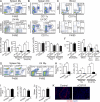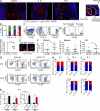Pretransplant CSF-1 therapy expands recipient macrophages and ameliorates GVHD after allogeneic hematopoietic cell transplantation
- PMID: 21536742
- PMCID: PMC3092347
- DOI: 10.1084/jem.20101709
Pretransplant CSF-1 therapy expands recipient macrophages and ameliorates GVHD after allogeneic hematopoietic cell transplantation
Abstract
Acute graft-versus-host disease (GVHD) results from the attack of host tissues by donor allogeneic T cells and is the most serious limitation of allogeneic hematopoietic cell transplantation (allo-HCT). Host antigen-presenting cells are thought to control the priming of alloreactive T cells and the induction of acute GVHD after allo-HCT. However, whereas the role of host DC in GVHD has been established, the contribution of host macrophages to GVHD has not been clearly addressed. We show that, in contrast to DC, reducing of the host macrophage pool in recipient mice increased donor T cell expansion and aggravated GVHD mortality after allo-HCT. We also show that host macrophages that persist after allo-HCT engulf donor allogeneic T cells and inhibit their proliferation. Conversely, administration of the cytokine CSF-1 before transplant expanded the host macrophage pool, reduced donor T cell expansion, and improved GVHD morbidity and mortality after allo-HCT. This study establishes the unexpected key role of host macrophages in inhibiting GVHD and identifies CSF-1 as a potential prophylactic therapy to limit acute GVHD after allo-HCT in the clinic.
Figures








Similar articles
-
STING negatively regulates allogeneic T-cell responses by constraining antigen-presenting cell function.Cell Mol Immunol. 2021 Mar;18(3):632-643. doi: 10.1038/s41423-020-00611-6. Epub 2021 Jan 26. Cell Mol Immunol. 2021. PMID: 33500563 Free PMC article.
-
Antigen-presenting cell-derived complement modulates graft-versus-host disease.J Clin Invest. 2012 Jun;122(6):2234-8. doi: 10.1172/JCI61019. Epub 2012 May 15. J Clin Invest. 2012. PMID: 22585573 Free PMC article.
-
Alloreactivity as therapeutic principle in the treatment of hematologic malignancies. Studies of clinical and immunologic aspects of allogeneic hematopoietic cell transplantation with nonmyeloablative conditioning.Dan Med Bull. 2007 May;54(2):112-39. Dan Med Bull. 2007. PMID: 17521527 Review.
-
Tolerogenic anti-IL-2 mAb prevents graft-versus-host disease while preserving strong graft-versus-leukemia activity.Blood. 2021 Apr 22;137(16):2243-2255. doi: 10.1182/blood.2020006345. Blood. 2021. PMID: 33511398 Free PMC article.
-
The Role of Co-stimulatory/Co-inhibitory Signals in Graft-vs.-Host Disease.Front Immunol. 2018 Dec 21;9:3003. doi: 10.3389/fimmu.2018.03003. eCollection 2018. Front Immunol. 2018. PMID: 30627129 Free PMC article. Review.
Cited by
-
Macrophages are required for host survival in experimental urogenital schistosomiasis.FASEB J. 2015 Jan;29(1):193-207. doi: 10.1096/fj.14-259572. Epub 2014 Oct 28. FASEB J. 2015. PMID: 25351984 Free PMC article.
-
Novel Insights Into the Mechanism of GVHD-Induced Tissue Damage.Front Immunol. 2021 Aug 27;12:713631. doi: 10.3389/fimmu.2021.713631. eCollection 2021. Front Immunol. 2021. PMID: 34512636 Free PMC article. Review.
-
Resident macrophages of pancreatic islets have a seminal role in the initiation of autoimmune diabetes of NOD mice.Proc Natl Acad Sci U S A. 2017 Nov 28;114(48):E10418-E10427. doi: 10.1073/pnas.1713543114. Epub 2017 Nov 13. Proc Natl Acad Sci U S A. 2017. PMID: 29133420 Free PMC article.
-
Emerging insights into epigenetics and hematopoietic stem cell trafficking in age-related hematological malignancies.Stem Cell Res Ther. 2024 Nov 6;15(1):401. doi: 10.1186/s13287-024-04008-4. Stem Cell Res Ther. 2024. PMID: 39506818 Free PMC article. Review.
-
M-CSF improves protection against bacterial and fungal infections after hematopoietic stem/progenitor cell transplantation.J Exp Med. 2016 Oct 17;213(11):2269-2279. doi: 10.1084/jem.20151975. Epub 2016 Oct 10. J Exp Med. 2016. PMID: 27811055 Free PMC article.
References
-
- Abe M., Cheng J., Qi J., Glaser R.M., Thall A.D., Sykes M., Yang Y.-G. 2002. Elimination of porcine hemopoietic cells by macrophages in mice. J. Immunol. 168:621–628 - PubMed
-
- Alyea E., Weller E., Schlossman R., Canning C., Webb I., Doss D., Mauch P., Marcus K., Fisher D., Freeman A., et al. 2001. T-cell—depleted allogeneic bone marrow transplantation followed by donor lymphocyte infusion in patients with multiple myeloma: induction of graft-versus-myeloma effect. Blood. 98:934–939 10.1182/blood.V98.4.934 - DOI - PubMed
Publication types
MeSH terms
Substances
Grants and funding
- R01 AI071185/AI/NIAID NIH HHS/United States
- R01 AI080884/AI/NIAID NIH HHS/United States
- AI080884/AI/NIAID NIH HHS/United States
- R01 HL086899/HL/NHLBI NIH HHS/United States
- R01 HL097819/HL/NHLBI NIH HHS/United States
- R37 CA026504/CA/NCI NIH HHS/United States
- HL086899/HL/NHLBI NIH HHS/United States
- CA112100/CA/NCI NIH HHS/United States
- R01 CA112100/CA/NCI NIH HHS/United States
- R01 CA026504/CA/NCI NIH HHS/United States
- R01 HL069438/HL/NHLBI NIH HHS/United States
- R01 CA032551/CA/NCI NIH HHS/United States
- R01 HL116340/HL/NHLBI NIH HHS/United States
- R01 AI 071185/AI/NIAID NIH HHS/United States
- CA32551/CA/NCI NIH HHS/United States
- CA26504/CA/NCI NIH HHS/United States
- R01 DK056638/DK/NIDDK NIH HHS/United States
- R01 HL69438/HL/NHLBI NIH HHS/United States
LinkOut - more resources
Full Text Sources
Other Literature Sources
Research Materials
Miscellaneous

